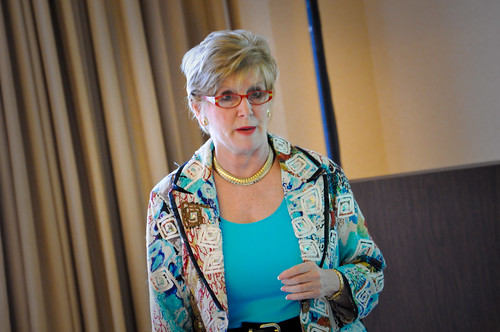How do you take non-profit board members and turn them into PR ambassadors so they help promote your mission, market your organization, recruit volunteers or raise funds? Sound impossible? Nope.
This interactive session by Cheryl Stock, president and CEO of C. Stock & Associates, Inc., explained the roles and responsibilities of board members, core principles of leadership and about the MAPS method of engaging and motivating your board to really get them “on board.”
Stock began full-time consulting, speaking, training and coaching after a successful 25-year career in marketing, sales and management. She has a master’s degree in non-profit administration, is a certified trainer in goal setting and motivation, is licensed in “Crucial Conversations,” a communication improvement/conflict resolution program, and is one of 325 trainers with Skill-Path, a leading provider of training programs for organizations worldwide. She received the “Trainer of the Year” award from the Non-Profit Resource Center in 2003 and is currently writing a book about strategies for excellence.
So why do we have a board?
When an organization is incorporated, the state in which the incorporation takes place assigns the function of organizational governance to a board of directors. A board is granted the legal authority to establish policies that will affect the life and work of the organization. A governing board is expected to represent the public trust by ensuring that the organization carries out the purpose for which it was established in a responsible and accountable fashion.
There are the ten basic responsibilities of a nonprofit board:
- Determine the organization’s mission and purpose
- Select the chief executive
- Provide proper financial oversight
- Ensure adequate resources
- Ensure legal and ethical integrity and maintain accountability
- Ensure effective organizational planning
- Recruit and orient new board members and assess board performance
- Enhance the organization’s public standing
- Determine, monitor and strengthen the organization’s programs and services
- Support the chief executive and assess his or her performance
What can make an exceptional board? Follow these 12 principles of an excellent board:
- Constructive partnership
- Mission-driven
- Strategic thinking
- Culture of inquiry
- Compliance with integrity
- Sustaining resources
- Results-oriented
- Intentional board practices
- Continuous learning
- Revitalization
- Independent mindedness
- Ethos of transparency
When you’re selecting board members, pick leaders with the following characteristics:
- Honest
- Forward-thinking
- Inspiring
- Competent
To engage board members, follow the “MAPS Method of Engaging Board Members”:
- M – Mission
- What are your MVPs?
- Mission – Stay true to your mission and continue to re-evaluate it.
- Vision – Use your vision to guide the image of success.
- Principles – What do you stand for? What are your beliefs and values?
- A – Action
- How do you select your board members? Are they mission driven? Volunteers? Friends of friends? Through an organization like the chamber of commerce?
- Diversity … make sure to mix it up. Our communities are changing.
- Provide a board handbook that specifically explains the responsibilities of the board and individual.
- P – Passion
- Have a board retreat
- Stay up-to-date within industry
- Keep board informed about industry changes
- Be willing to change/modify/add programs
- Make sure board meetings are interesting
- Have rules for attendance
- Participation guidelines
- Use contracts
- Use term limits
- Make sure they know they make a difference
- Say thank you
- Do self-assessments
- Have an education item on every board agenda (for example, roles of board, leadership, organization, feedback, etc.)
- S – Showmanship
- Show and tell
- Conduct tours or orientations at other times
- Industry and guest speakers
- Updates from those you serve and from staff
- Share what you hear and see
- Incorporate in events
- What are your MVPs?
Remember to “be the word that spreads.” If you are speaking negatively about your organization to your friends and family, it is also probably coming across that way to your board too.
Contact:
Cheryl Stock
C. Stock & Associates, Inc.
cheryl@cherylstock.com

